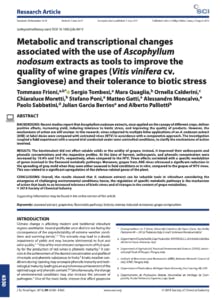BACKGROUND: Recent studies report that Ascophyllum nodosum extracts, once applied on the canopy of different crops, deliver positive effects, increasing yield, inducing tolerance to biotic stress, and improving the quality of products. However, the mechanisms of action are still unclear. In this research, vines subjected to multiple foliar applications of an A. nodosum extract (ANE) at label doses were compared with untreated vines (NTV) in accordance with a comparative approach. The investigation coupled a field experiment with a second trial conducted under semi-controlled conditions, to clarify the mechanisms of action involved.
RESULTS: The biostimulant did not affect soluble solids or the acidity of grapes; instead, it improved their anthocyanin and phenolic concentrations and the respective profiles. At the time of harvest, anthocyanin, and phenolic concentration were increased by 10.4% and 14.5%, respectively, when compared to the NTV. These effects correlated with a specific modulation of genes involved in the flavonoid metabolic pathways. Moreover, grapes from ANE vines witnessed a significant reduction in the spreading of gray mold when they were either assessed in field conditions or in vitro, compared to the grapes of NTV vines. This was related to a significant upregulation of the defense-related genes of the plant.
CONCLUSIONS: Overall, the results showed that A. nodosum extracts can be valuable tools in viticulture considering the emergence of challenging environmental conditions; hence, the regulation of specific metabolic pathways is the mechanism of action that leads to an increased tolerance of biotic stress and of changes in the content of grape metabolites.
© 2019 Society of Chemical Industry
